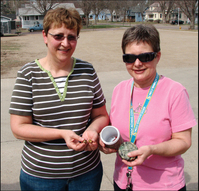There’s treasure everywhere.
That’s how Vermillion geocachers Becky Rider and Diane Leja have felt as they’ve found and hidden caches in town and elsewhere for the past three years.
For those not in the know, geocache is a global scavenger hunt that utilizes GPS technology.
“People will hide anything from a button-sized magnet to a five-gallon pail,” Rider said.
“The difficulty of finding it varies on the way it’s hidden.
You’re looking to not make it impossible to find, but you want to –”
“Give a challenge,” Leja said.
Rider nodded, adding, “You want to hide it in a way that the general, non-caching public doesn’t know it’s there.”
“Hidden in plain view,” Leja said.
There’s no better way to describe it, really. Each day non-cachers unknowingly pass by the items, which are hidden literally everywhere. Fence posts, signs, gates, trees, you name it.
According to Rider, there are currently about 105 caches hidden in Vermillion, more than 30 of which have been placed there by she and Leja.
The caches themselves are a container that holds a roll, which the finders then sign the specific ID number they’re given online.
“That’s the main thing, you have to sign the log to prove you were there,” Leja said. “Then you have to go back online and say that you found it.”
In fact, all of the information about caches and where to find them is available on the Internet at www.geocaching.com, which gives the GPS coordinates, levels of difficulty and user ratings.
Leja said most cachers begin strictly as finders, although it doesn’t take long before they begin to get ideas for hiding places.
“You’ll drive by a place and say, ‘Well, that would be a good place for a geocache,’” she said. “A lot of times you’re trying to bring someone to an interesting spot, something they wouldn’t have seen otherwise. A historic spot, a beautiful scene. Then, there are some places that are just plain random.
“Once you get into the game, then the next logical step is to become a hider also,” she said.
“It’s self-perpetuating,” Rider added.
Once they get an idea about where to put a cache, they register online to see if there are any others in the area, and they must receive approval from a local geocache official, of sorts.
They said their biggest concern when creating a new cache is determining the coordinates.
“You try to be really careful and check them out, because depending on which satellite you pull it off of at any given moment, they can vary a little bit,” Leja said. “Sometimes we’ll take the coordinates, and then we’ll walk away, and then try to (find it) to see how it comes out.”
They do maintenance on their many caches each spring.
“They disappear, or they just get ruined,” Leja said. “Some stuff went away in the flood a few years ago.”
The pair were introduced to geocache by Leja’s sister, who lives in Michigan.
“She’d been telling me for a couple years that we would enjoy this, and until we actually went and did it with her we didn’t know, and then we just jumped in with both feet after that,” Leja said.
They certainly did. Their car – or “cachemobile” – is now filled with the various tools of the trade they need to find and hide caches.
There are tweezers to get logs out of tiny caches, there are rollers that allow the logs to be put back into those tiny caches, there are gloves, walking sticks, hooks for grabbing things, a stepladder and many containers.
They’re always on the lookout for something they might be able to use.
“Hardware stores are great places to look for things that you could turn into a cache,” Leja said. “It’s been fun to come up with containers, because if your location isn’t necessarily interesting you hope maybe your container is fun.”
The hiding places themselves can also be memorable. One in Chicago utilized a piece of PVC pipe. The pipe had a hole at the bottom, but needed to be filled with water for the cache to be found.
“When you plug the hole, the water rises and the cache comes to the top and you pull it out and sign it,” Leja said.
Another favorite made use of an artesian well, the water of which rose and fell several times an hour.
“You sit around and wait for 15 minutes, and the water goes up and fills this pond, and then it goes away,” Rider said. “We sat through a few cycles just watching it.”
There’s geo-art, too, Leja said.
“People will place caches so that when you look at them on the map they either form a design or spell something,” she said. “In fact, there’s one up by Lennox that actually spells out ‘geocache.’”
Not content with geocaching in South Dakota alone, they’ve gone both west and east, to Wyoming and Illinois, among other locations.
One of their favorite spots is Chicago, which is near the home of Rider’s brother and his family.
“(Leja’s) sister got us hooked, and we got my brother and his family hooked,” Rider said. “Whenever we go out there, we go out together. We actually had a couple big milestones together. The first was, they had 700 (finds) and we had 800. …
“Then the next time we were out there we both had 1,000,” she said. “They worked really, really hard to catch up, so we got a joint 1,000 find out there a year ago Thanksgiving.”
Leja and Rider said one of the best parts of geocaching has been simply getting out and learning more about the community.
“We’ve lived here over 20 years, and we’ve been to places in Clay County I didn’t know existed,” Leja said.
Rider agreed, adding, “Once you know about it, it’s like it opens up a different world.”



